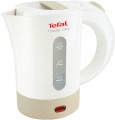Coating of the heating element
The outer covering of the heater is a significant factor in determining the characteristics of the kettle because it is in direct contact with the heated water. Therefore, the material used for this coating is an essential consideration in the kettle's properties.
— Stainless steel. "Stainless steel" is the most commonly used coating for kettles as it is affordable and provides good resistance to scale buildup. However, compared to more advanced materials, it may not offer the highest level of scale resistance.
— Aluminium. Another common material, slightly more expensive and resistant to scale than stainless steel, but in general not having significant differences.
— Ceramic. Ceramic coating is known for its exceptional resistance to both scale and corrosion. Although it cannot provide a complete guarantee against scale buildup, it does tend to form plaque at a much slower rate than on surfaces made of steel or aluminium. Additionally, many of these heaters can be cleaned with more aggressive descaling products that would not be suitable for metal coatings. However, due to their high cost, ceramic coatings are typically only used in premium kettles.
— Silver. Silver is another premium material that has good resistance to both scale and corrosion. In addition, it also possesses some antibacterial properties, making it a suitable choice for those who use the kettle to store cooled boiled water. However, the cost of silver pla...ting is quite high.
Opening the lid with a button
Kettles (see "Type") in which the lid opens at the touch of a button. This opening is faster and more convenient, and often safer than the traditional way (grab the lid and pull it up): the lid can get quite hot when the kettle is in operation, and long contact with it is fraught with burns. And although the button can also be placed on the lid, a short press is enough to activate it, and even in such cases the risk of getting burned is minimal. On the other hand,
opening the lid with a button complicates the design of the kettle and reduces its reliability.
Body shape
The general shape of the body of the electric kettle.
—
Conical. The most popular option: a body is wide at the base and tapering upwards. This form contributes to stability: the centre of gravity is maximally displaced downwards. However washing such a kettle from the inside may not be very convenient due to the relatively small size of the opening in the upper part.
—
Cylindrical. The cylindrical shape provides more or less the same width of the body at the base and at the top. With the same height and base diameter, such kettles hold slightly more water than conical ones; in addition, such a device is easier to clean due to the wide opening for the lid.
—
Inclined. The body which is inclined forward; the width of such a body is usually more or less the same over the entire height. Such kettles have an unusual, eye-catching appearance; in addition, it is easier to pour water from them — the device must be inclined at a smaller angle than with a cylindrical and even with a conical body. However, this option does not provide fundamental advantages over the same cylindrical shape, but it is more expensive, and therefore is not common.
Controller
The name of the controller installed in the device.
The controller is called an electronic circuit, which is directly responsible for managing the operation — primarily for turning off the heating when boiling or turning on without water. In our catalog, the name of such a circuit is specified if we are talking about an advanced controller that significantly exceeds most solutions on the market in terms of quality and reliability. At the same time, the specs indicate not a specific model, but a general brand — this is quite enough in this case.
The most reliable, durable and safe nowadays are the controllers of the British manufacturers Strix and Otter. There are no fundamental differences between these options in this regard, any of them is a sign of a quality kettle (even if the overall functionality of the device is rather modest). On the other hand, such equipment affects the price.

